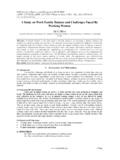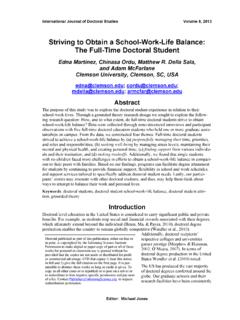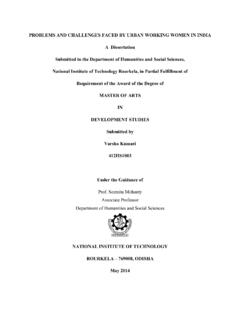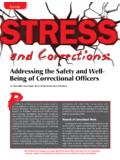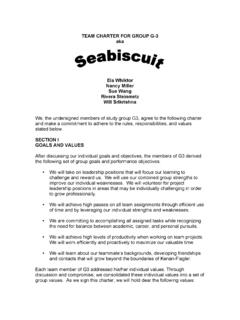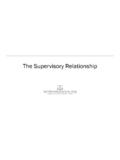Transcription of Balance between formal and informal learning - …
1 Balance between formal and informal learning - experience and challenges of civil servants training in Serbia Milan Radakovi 1 Sne ana Antonijevi 2 Abstract The Professional Training Centre of the Human Resource Management Service achieves its goals regarding the improvement of knowledge, skills and capabilities of public servants according to the reform processes through various types of training with highly competent trainers. This paper will describe experiences of The Professional Training Centre in developing and delivering training. Methods of civil servants improvement that are used so fare are: formal training, mentoring, coaching, e- learning . Examples will be given for each of these methods, as well as the influence that they have on improvement of knowledge in public administration. Paper will describe advantages and disadvantages of formal training and informal learning and why this elements not be treated as self-sufficient or sole form of civil servants development, but complementary and compatible among each other.
2 This is important having in mind the process of reforms and accordingly the need for appropriate, systematic and result oriented learning . 1. Introduction With the development of information society and modern teaching methods, learning opportunities became larger, without borders and instantaneous. Professionals can learn and acquire new skills and competencies in a vast amount of ways comparing to the traditional ways ( formal learning ). Important part of learning happens at the workplace, in organizations specialized for trainings and on-line through internet, mobile devices and e- learning portals. Adult education is based on lifelong learning . It can be formal , non- formal and informal . Today, lifelong learning concept is essential for individuals who want to stay up to date with rapid economic and technological changes.
3 formal education which today represents a ticket to the world of employment, especially in the Serbian public administration is no longer sufficient if an individual wants to build a successful career. formal learning is defined by the CEDEFOP Glossary (2008) as: learning typically provided by an education or training institution, structured (in terms of learning objectives, learning time or learning support) and leading to certification. formal learning is intentional from the learner s perspective. In other words, it includes courses, classes, face-to-face workshops, other training or educational events that lead to some certification or validation. informal learning is therefore: learning resulting from daily work-related, family or leisure activities. It is not organised or structured (in terms of objectives, time or learning support).
4 informal learning is in most cases unintentional from the learner s perspective. It typically does not lead to certification. Non- formal learning is: learning which is embedded in planned activities not explicitly designated as learning (in terms of learning objectives, learning time or learning support), but which contain an important learning element. Non- formal learning is intentional from the learner s point of view. It typically does not lead to certification. Non- formal adult learning means organized learning processes aimed at capacitating adults to work and their training for different social activities or personal development. Some examples are: programmes to impart work-skills, literacy and other basic skills for early school-leavers; in-company training; structured online learning ; courses organized by civil society organizations for their members, their target group or the general public.
5 informal learning is considered as a lifelong process in which we acquire information, attitudes, skills and knowledge. It can be intentional and unintentional and it can be encouraged by the development of techniques and technologies. We live in an information society that gives us endless opportunities for informal learning . It is not necessarily intentional learning , and because of that it can go unnoticed by individuals in terms of acquiring knowledge and skills. informal learning is acquired through life and work experience, from the experts and colleagues at work, in project groups, using the internet, manuals and guidelines, through network of professionals etc. informal learning can be in form of: project-management or IT skills acquired at work; languages and intercultural skills acquired during a stay abroad; IT skills acquired outside work; skills acquired through volunteering, cultural activities, sports, youth work and through activities at home ( taking care of a child).
6 According to Tissot (2008) informal learning is the result of daily activities, it is not organized and intentional from the perspective of one who learns and so does not lead to certification." According to the EU Commission (2000) informal learning is a natural companion of everyday life. Unlike formal and non- formal learning , informal learning is not necessarily intentional and thus may be unrecognized even by individuals themselves as contributing to their knowledge and skills. Therefore, informal learning is characterized by being "non-institutional" versus " learning outcomes" that formal and institutional learning has. All this makes informal learning can hardly suitable to define or analyze. Below we will discuss the formal and informal learning in the context of public administration and improving the competence of civil servants.
7 1 PhD student, Faculty of Organisational Sciences, Republic of Serbia 2 Head of Professional Training Center, Human Resource Management Service, Government of the Republic of Serbia, Republic of Serbia 2. formal and informal learning pros and cons formal and informal learning are both learning . They both involve building new neural connections in the brain and adapting to new conditions. They are very much the same. (Cross, J, 2007) In terms of the INTENTION of the learner; both formal and non- formal learning is intentional ( the individual sets out with the intention of learning something), whereas with informal learning it is (mostly) unintentional ( it happens as a consequence of doing something else). With informal learning , the learner may be aware s/he has learnt something, but in many cases may be totally unaware of it.
8 From a business point of view learning /training outcomes may produce a normal range of expected and intentional learning . But if we are talking about non-intentional learning , it is difficult to establish a targeted group of customers / consumers and appropriate solutions. Various sources suggest that 70-90% of learning activities is informal . Table 1 presents some differences between these two types of learning . Table 1 Table of differences between formal and informal learning formal learning informal learning learning through institutions The result of daily activities related to work, family and leisure time Structured in terms, names, purposes, goals and learning support Flexible, unstructured in terms of goals, objectives and learning support Results with a certificate Usually does not lead to a certificate Intentional It may be intentional but in most cases the non-intentional The both, formal and informal learning , have certain advantages and disadvantages and benefits for different participants in working a and learning environment.
9 Benefits of formal learning : Large numbers of employees will learn the same information and/or processes at the same time; If properly designed, the course content should be accurate and up to date; Employees learning through formal training programs come up to speed faster once they start their jobs; Properly designed formal training programs can include a variety of methods to appeal to all learning styles and conform to adult learning principles. Benefits of informal learning : Creating informal learning situations can be less costly and more time efficient given all of the social media technologies and electronic devices we have today; learning informally can be more personal and less intimidating for some people; Subject-matter experts may be more willing to share their knowledge with others this way; Since learning this way happens more naturally during the flow of someone s work day, employees may be less likely to resist learning new things.
10 There are lot of methods and tools for informal learning . Results of research conducted by ASTD (2008) in Figure 1 indicate that employees mostly as a means of informal learning use internet (Google, e-mail, Facebook, MySpace, intranet) and coaching, mentoring, meetings, communities of practice, network etc. Figure 1 Usage of informal learning Tools/Processes (percent responding to High or Very high Degree, Top 15) Concept of lifelong learning connects individual parts of education and particular forms of education ( formal , non- formal , informal ) into a single composition. informal learning is also becoming increasingly important in a global and interconnected world where technology allows individuals to learn in vast amount of ways through for example open educational resources and at a distance.

